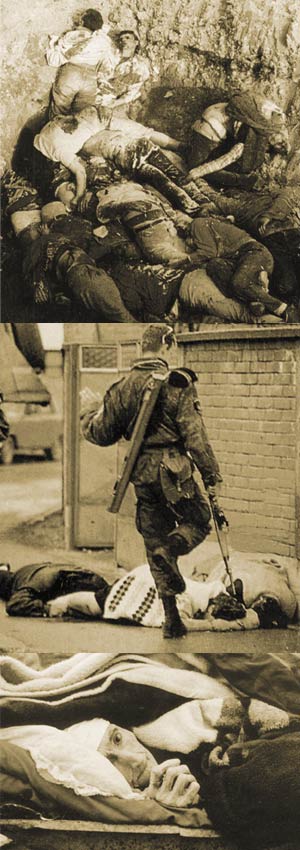 |
Towards the end of the twentieth century, the world witnessed a huge and terrible genocide. It began in 1992, and over its course hundreds of thousands of people were thrown out of their lands, killed, thrown in concentration camps, and subjected to inhuman torture. The most striking and singular feature of this genocide, which began in Bosnia and then moved to Kosovo, was that it took place before the eyes of the whole world, right next door to the countries of Europe.
The savagery in Bosnia which began in 1992 lasted until the spring of 1995. Throughout its course there was violence the likes of which has seldom been equaled in history. The number of Bosnian Muslims killed by the Serbs was more than 200,000. Fully 2 million people were exiled from their homes, and some 50,000 Muslim women were raped. The same things happened later in Kosovo.
 |
In order to understand this savagery inflicted on the innocent Muslims of Bosnia, we first need to take a look at the history of the region. It is well known that after the dissolution of the Yugoslavian Federation, some countries became uneasy at the way a number of regions with majority Muslim populations were heading towards independence. The setting up of independent Muslim states in the middle of Europe, and the possibility that these might form a union amongst themselves, meant Islamic civilization coming uncomfortably close to Western states. For that reason, the Muslims in the Balkans were subjected to genocide by the Serbs, with secret encouragement by the effective anti-Islamic lobbies in certain Western countries and under the security umbrella of those lobbies.
Even before people had forgotten the terrible atrocities in Bosnia-Herzegovina, a second wave of Serbian savagery began, this time in the Yugoslavian republic of Kosovo. Looking at these events from a historical perspective, it seemed that the Serbs were trying to avenge the pain of their defeat some 600 years previously. The Serbs in Kosovo see the Muslim Albanians as a "continuation of the Ottoman Empire," for which reason they are set on a policy of assimilation, or more accurately, are trying to do away with all traces of the Ottomans.
 |
| We will certainly help Our Messengers and those who believe both in the life of this world and on the Day the witnesses appear, the Day when the excuses of the wrongdoers will not help them. |
The hatred of the Serbs for the Ottomans goes back over 600 years. During the First Kosovar War, in 1389, Sultan Murat I was stabbed and seriously injured in the northwest of Pristina by a Serb disguised as a messenger. Murat eventually died after witnessing the Ottomans' victory. The second great Ottoman victory in Kosovo took place in 1448, when Sultan Murat II found himself facing a crusader army led by the Serbians, and he defeated them. Following the Second Kosova War, Muslim Turks settled in the Balkans in large numbers.
Throughout the centuries that the Balkans remained under Ottoman rule there was no ethnic problem of any magnitude, but rather a general air of peace and security. However, certain international powers stirred up feelings of nationalism in the Ottoman territories, which led to the Balkan wars. When these came to an end, those same powers reshaped the region. This new order turned the Balkans into a battleground in the making.
 |
| Sights such as this became a normal part of daily life in the Balkans. |
The new map of the Balkans which was agreed upon at the Treaty of Versailles at the end of World War I highlights one interesting fact: Instead of uniting the Albanians – a key segment of the population of the Balkans – in a single state, they were left scattered over a number of countries. Why were the Albanians not brought together within common borders when the map was drawn up?
In the answer to that question lies the fundamental cause of all the conflict there up to our day. The prospect of the formation of a "Greater Albanian" state, one made up of Muslim Albanians, is regarded by certain international powers as not being in their interests. The reason why no solution could be found to this decade-long problem lies in yet the same idea. If Kosovo is recognized as independent, a "Greater Albania" could again be established in the southern Balkans.
Albanians make up more than 95 percent of the population of Albania. Moreover, there is an important Albanian population of 35 percent within the borders of Macedonia, and some 50,000 Albanians live in Montenegro. Within Yugoslavia, the region of Kosovo also has a large Albanian population.
What if these neighboring countries were to unite, thus forming a "Greater Albania" in the heart of Europe? That is one fear of the Western powers.
It should be made clear that this fear has more to do with religion than ethnicity. Just as with Bosnia, a state here consisting mainly of Muslims is seen as "undesirable." The fact is, however, that the presence in the Balkans of a strong Muslim state that fully abides by the moral values of the Qur'an will guarantee justice, well-being, peace and security for the people of the whole region.
 |
| The 1 million or so Kosovar Muslims who fled Serbian oppression had to contend with cold, hunger, thirst and disease. Tens of thousands lost their lives, and many more disappeared. |
But, this calculation, which still applies today, played an important role in the drawing up of the map of the Balkans after World War I. That is why the Albanians have lived as an unwillingly divided nation ever since.
After World War II, the Albanians were ruled by communist regimes. The Albanians of Kosovo and Macedonia remained within the borders of Tito's Yugoslavia, and Albania itself fell into the hands of Enver Hoxha's more oppressive regime.
Following the collapse of communism over 40 years later, the powers which perceived a potential "Greater Albania" as a threat due to its Muslim nature again moved into action. It was the former communist and new fascist Slobodan Milosevic who began using savage methods to carry out this anti-Islamic policy.
As soon as Milosevic came to power, he ended the autonomy that had been granted to Kosovo in Tito's time. He began holding fascist-style meetings to fan the flames of Serbian nationalism. Places of higher education in Kosovo were barred from teaching in Albanian, newspapers publishing in that language were closed down, and the people were oppressed. It was intended that the Albanians should leave the region, and in fact some 400,000 did so during that time. At the same time, there was an attempt to change the demography of the region by moving in Serbs. They wanted to "Serbianize" the region by getting rid of the Muslim Albanians who made up fully 90 percent of the population. They even tore up property deeds and marriage documents in order to erase the Muslims' cultural identity. In 1989, Kosovo's autonomy was revoked altogether. Every day, Milosevic imposed new sanctions on the region.
The Albanians continued their peaceful resistance in the face of all the measures being used against them, and under the leadership of Ibrahim Rugova they began a constitutionally based campaign to win back their rights. The Albanian people, who had lived for many years under an oppressive system possessing no rights at all and as targets of assimilation, began to attract the attention of the world when they were subjected to ethnic cleansing. The Serbs poured police and troops into the region. These forces attacked the population, which lacked any means of self-defense, using heavy weapons. It was Feb. 27-28, 1998 when the systematic ethnic cleansing campaign began. Serbian aggression was halted by the NATO operation on March 24, 1999. However, the fact that this operation came late meant huge suffering being inflicted on the Kosovar Albanians.
ETHNIC CLEANSING BBC News, July 6, 1999 IN THE BALKANS |
  |
| Forced to leave their homes because of threats or attacks, by March 1999 the Muslim population of Kosovo started to flee, leaving their villages desolate. Approximately three months later, when they returned, nothing was the same. Houses burnt and in ruins, relatives lost, children sick and properties plundered... War and migration threw every Muslim Kosovar's life, rich or poor, into complete disarray. |
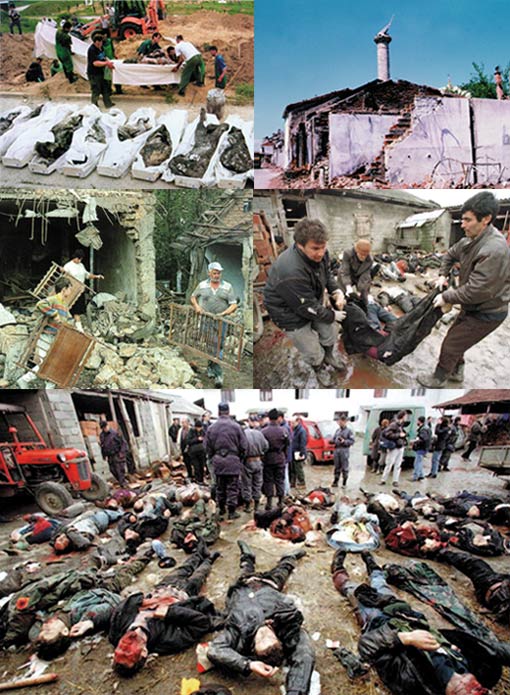 |
| Photographs of what was going on in Kosovo were published in newspapers all over the world, yet the world was determined to ignore it. Mass graves, burned-out houses, and babies murdered in their cradles meant nothing to most people. |
When Sarajevo became part of Ottoman territory in 1463 it also came into contact with the religion of Islam, and it remained an Ottoman domain for some 400 years. Throughout that long time the Slavs, linked to a Christian sect called the "Bogomils" and living in the area of Bosnia-Herzegovina, turned to Islam of their own free will. A Muslim people thus emerged in Bosnia, in the middle of the Balkan Peninsula. With the 1878 Treaty of Berlin, Bosnia was given over to the Austro-Hungarian Empire, although in effect it still remained part of the Ottoman territories. But the empire occupied it in 1908, and Bosnia was no longer under Muslim rule. The Bosnians bade farewell to the withdrawing Ottomans with much regret, as they guessed the persecution they would suffer under their new rulers. Indeed, no sooner had the Ottomans withdrawn than attacks on and harassment of Muslims began.
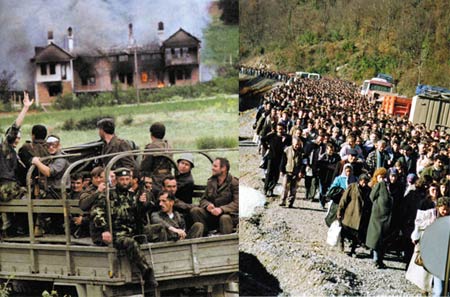 |
| The Serbs continued their pillaging and murder even as they withdrew from Kosovo. The 1 million Kosovar Muslims who fled lived through a human tragedy of enormous proportions. |
After World War I the "Kingdom of Serbia, Croatia and Slovenia" was established, thus bringing together all the Slav communities in the region. Bosnia-Herzegovina also became part of the kingdom. In 1929, the running of the state, now called the Kingdom of Yugoslavia, fell into the hands of Orthodox Christian Serbs. Until World War II, Bosnian Muslims had their goods and property stolen and were kept under close watch.
 |
| Some 200,000 Bosnian Muslims were killed by the Serbs in three years, and another 2 million Muslims who were forced to flee their homes had to struggle to survive under terrible conditions. |
During World War II the region was occupied by the Germans. The war years saw 100,000 Muslims killed in attacks on Bosnian towns and villages by ultra-nationalist Serbian partisans (Chetniks). The communists played an important role in the resistance against the Nazis, and when the war ended they took over the country's administration. The policy of oppression of Muslims began anew when the communists came to power. Islamic foundations were taken over, mosques and religious schools were seized, and an intensive campaign of atheist propaganda began. As a result of this pressure, one part of the Muslim population of Bosnia-Herzogovina was forced to migrate to Turkey and other European countries.
 |
| During the Bosnian War, the streets were literally turned into cemeteries. The mass graves that were unearthed one-by-one after the war laid bare the tragic dimensions of the genocide. |
Following the collapse of the Cold War Warsaw Pact, a referendum was held on March 1, 1992, and Bosnia-Herzegovina declared its independence. However, the Serbs then occupied the country and began three years of slaughter. The number of Bosnian Muslims killed by the Serbs in just those three years totalled more than 200,000. Some 2 million Muslims were forced from their homes. Fifty thousand Muslim women were raped. Muslims sent to Serbian concentration camps were subjected to unbelievable torture, and tens of thousands of them were crippled.
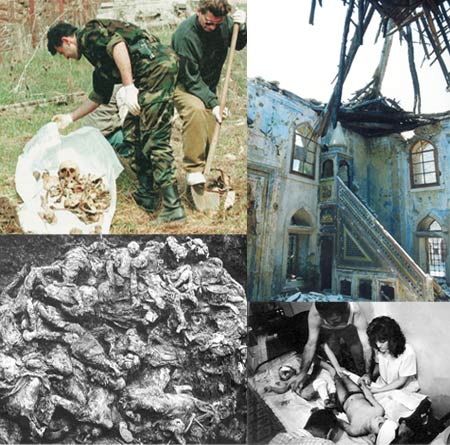 |
| Serbian troops attacked the innocent civilian population and murdered children. Mostar Hospital witnessed such awful scenes throughout the conflict (below). |
Some of the cases of torture inflicted on the Muslims were taken up by the United Nations' International War Crimes Tribunal. Statements given by Muslims there show the extent of the persecution they were subjected to. For example, according to a statement by 46-year-old Sulejman Besic, a Chetnik called Dusan Tadic went up to a Muslim woman one day and shouted at her to tell him where her husband was. He later told the woman to undress, threatening to kill her if she refused. In tears, she began to strip, at gunpoint. In less than a minute, however, Tadic shot her in the head. That same Chetnik then brought her son, who during this horrific scene had been lying a short distance away with his hands tied, and ordered him to rape his dead mother. The young man then gave out a terrible cry, and was immediately shot dead by Dusan Tadic.
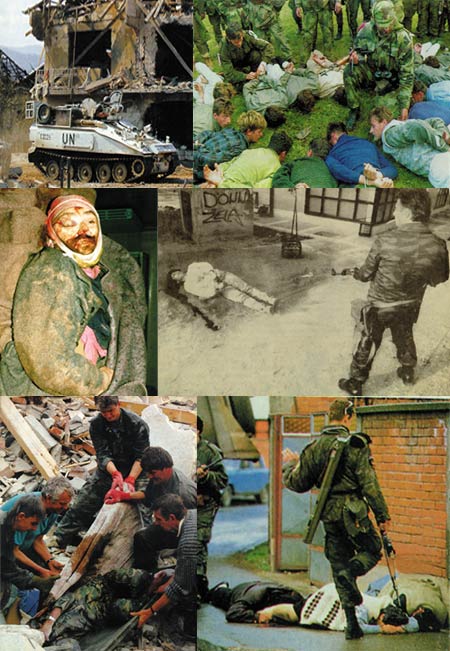 |
| Serbian troops first tortured the Muslim Bosnians they caught, and then killed them. The bombed houses where innocent people had been taking shelter became their tombs. |
Bodies lay at the scenes of their murders for long periods. Such a thing was nothing extraordinary in the concentration camps. According to Sulejman Besic, many injured Muslims were in a truly terrible situation. Some of them lay unconscious as maggots crawled in their open wounds. The stench given off by the corpses lying in the open and the maggot-infested flesh was truly dreadful.
 |
| After Karadzic and Miladic, the responsibility for the Srebrenica massacre lay with Serbian commander Gen. Obrenovic. He and his men bombed the town for five days and killed 7,500 Bosnian civilians trying to flee. They buried the bodies in mass grave in order to stop the news from getting out and destroy the evidence. However, after the war the mass graves that Obrenovic and the other generals were so keen to conceal were unearthed one by one. |
Besic witnessed these things during internment in the Trnopolje camp, and he spoke of his experience to the International War Crimes Tribunal in the Hague, which was set up to investigate war crimes in the former Yugoslavia and try the suspects. These terrible things he both witnessed and experienced were just a few examples out of thousands of the systematic torture and slaughter inflicted on Muslims by the Serbs in Bosnia.
A Picture of Serbian Cruelty ... |
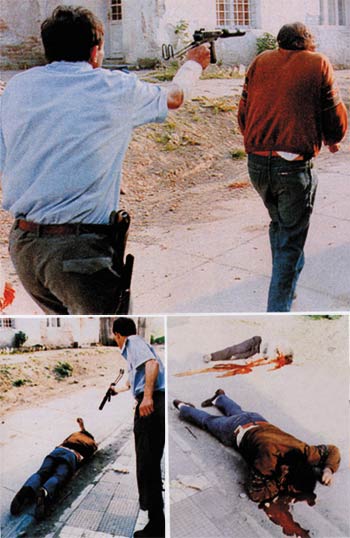 |
| Terrifying pictures of the 1992 killing of a defenseless Muslim by a Serbian police officer.... |
The long savagery and ethnic cleansing in Bosnia may have come to an end, but it left behind it a great human tragedy. The Serbs carried out their threats, and responded to the rise of Islam in Bosnia with an enormous slaughter, carried out before the eyes of the entire world.
Our fervent wish is that the people of Bosnia, who were subjected to that savage genocide simply because they were Muslims, will be actively and practically supported by people of good conscience in all societies, and particularly the Islamic world on their path to recovery.